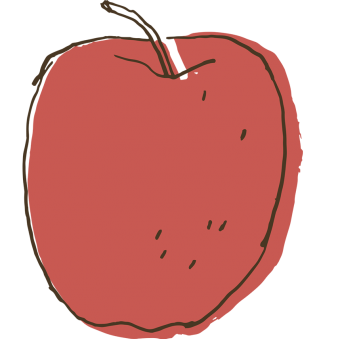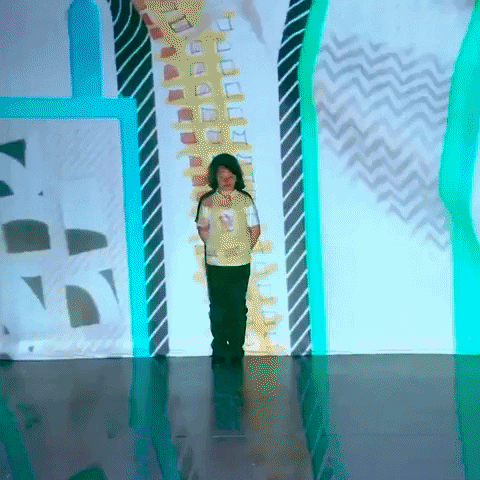“It is the look of someone who is the process of losing something of who she thought she was. Upon encountering something outside herself and her own ways of thinking, she is giving up thoughts she previously held as known, and as a consequence she is parting with a bit of her known self.” (Ellsworth, p.16).
Hello everyone,
I feel super lucky to be a part of this course – I value the arts so much and see the importance of letting children express themselves not only through the arts for arts sake, but through a different approach to other subjects too. The reading this week, although challenging, was rewarding and validated many of the practices I hold dear. I think this reading asked us a class to think outside the box and consider that what we say to kids is not the only thing that affects their learning – the space in which they learn, our actions and often what we do not say is just as important. I loved the image below by Juliahna Taggart because to me, it shows that for some kids, there world is grey until they are able to open their mind to art and expression and then it floods with colour. What a beautiful idea.
After reading through Ellsworth’s Places of Learning: Media, architecture, pedagogy chapter’s 1 and 2, I realized that academic writing around pedagogy CAN be poetic and artistic its delivery. Below my plan is to highlight pieces of this work that stood out to me and why they did so…come along for the ride!
- “Each of these other looks hinges on comprehension of a particular kind of knowledge – a knowledge already gotten by someone else. For various social, political, economic, or pragmatic reasons, someone has deemed this knowledge to be in need of being grasped, passed on, and repeated yet again and in ways that are clearly mapped and understood” (p. 16). My thoughts were, who’s knowledge is this that we value and deem important and “true” enough to pass on and teach? This could be an example of colonialism sneaking into our classroom through privileged knowledge.
- “D.W Winnicott’s notion of ‘transitional space’ as the time and place out of which experiences of learning emerge.” (Winnicott, 1989). This tells me that all the pieces need to fit together to satisfy the journey of learning.
- “Herbert Muschamp, architectural critic for The New York Times, also agrees that pre-and non-linguistic experiences of a place of learning are crucial to what is learned there.” (p. 20). We must, must, must situate ourselves and remember how important place is to learning. Our EAL students and students who struggle with language depend on us to understand this because that is how they see, hear and feel the learning we offer when language isn’t an accessible option.
- On page 22 in Ellsworth’s piece there are many nods to inspiring a sense of wonder in our students – “wonder is deeply interfused with the experience of learning.” Allow kids to wonder about the world around them inspires creativity and infuses art into everything we do.
- “Some use theories of ideology and discourse to understand how social, cultural, and sexual differences mark bodies and position them differentially within relations of power. These approaches have shown how some social dynamics make some bodies matter more than others, and that they make social and cultural differences figure in the human interests that shape the social constructions of knowledge” (p. 23). This sounds like the beginnings of systemic racism in our schools and divisions. Some bodies and cultures are valued and some are not. Students shape their feeling of school on these social constructs and we MUST make changes so every child can see their value in our learning spaces. It is crucial to feel our learning and every child should have the opportunity to feel it in a positive way. Arts Education allows for celebration at working and looking at things differently.
- “Regarding pedagogy as experimentation in thought rather than representation of knowledge as a thing already made, creates a profound shift in how we think of pedagogical intent or violation – the will to teach.” (p. 27). This idea would help break down colonial thinking and systemic racism in our schools. We can view all knowledge as equal it is an experiment and not just some thought that already exists. We can slow down and learn from what one another has to offer in the classroom and understand the importance without negative intent or violation as mentioned above.
- “Winnicott’s transitional space is what makes possible the difficult transition from a state of habitual (‘natural’ feeling) compliance with the outside world, with its expectations, traditions, structures, and knowledge, to a state of creatively putting those expectations, traditions, and structures to new uses.” (p. 30). This for whatever reason got me thinking about the fact that this could be the basis of mindfulness in the classroom. We are asking students to take outside world and it’s expectations, suspend them and use them for new.
- “A field of emergence (of newness and self change) takes shape when our minds/brains and bodies pass through time, space, and events – and do so with undetermined directions and outcomes”. This is what allows us to be who we are! Arts Education is a field of self exploration from many aspects. We form our worldview through not only our brains but our bodies and our spaces and the time in which we spend there. They are interconnected and help us form all aspects of ourselves when given the chance.
- “Change website, gestures towards the pedagogical potential of Wodiczko’s work when he says that Wodiczko’s ‘ephemeral projection pieces only last a night or two, but they reclaim the city streets as places for discussion and heated debate.” (p. 41). This is a pedagogy for slow, steady change as mentioned in the Villanueva and Sullivan article. This is art for social change, it’s art to give people without a voice, a voice. Art can move us regardless of whether the physical piece sticks around or not. We can use this as a lesson to teach kids that art can be fleeting and it’s ok. People will remember.
 Essentially what I got from my initial reading of this article was that arts education engages all of our senses and that kids need more art. It asks us to look at the world in a different way and celebrate how beautiful our world can be through everyday art like architecture, poetry, etc. It encourages us to consider pedagogy in a new that we hope can reach and benefit more and more of our diverse classrooms.
Essentially what I got from my initial reading of this article was that arts education engages all of our senses and that kids need more art. It asks us to look at the world in a different way and celebrate how beautiful our world can be through everyday art like architecture, poetry, etc. It encourages us to consider pedagogy in a new that we hope can reach and benefit more and more of our diverse classrooms.
There were many take away’s from “Analyzing the Degree of Consensus in Current Academic Literature on Critical Pedagogy” by Catalina Villanueva and Carmel O’Sullivan. Although this article was written in a dramatically different way than the first, there was value in it as well. Please find my ideas below:
- “They saw schools as places where dominant views and beliefs can be legitimized and normalized, while marginalized knowledge is silenced.” (p. 70). This is very similar to how schools are here in Saskatchewan. We still battle systemic racism, divisions based on dominant view and although marginalizing voices intentionally is getting better, by not recognizing knowledge and minimizing the effects of poverty and colonialism we are silencing our doing just that.
- “Through TO, Boal (2002: 15) promoted an active stance in spectators, who influence theatrical action directly, becoming ‘spect-actors’ rather than spectators.” (p. 71). Theatre for change! Freire showed people that you could empowered through education. Boal said that theatre can transcend demographic and language – what a powerful thing in diverse classrooms!
- “The literature seems united in that, in its current form, Critical Pedagogy aims to combat oppression of all kinds, including that based on race and ethnicity, gender, age, ecological factors, special needs, social class and also classroom roles.” (p. 75). Oppression doesn’t just come in a “one size fits all” model, many factors play into members of our society feeling oppressed. Theatre is a wonderful outlet for evolution – be it slow or quick as suggested in this piece, the fact that theatre is a path towards it is amazing. I just think we need to be cautious of that fact that Critical Pedagogy is not “invariably liberating” and that although we are exploring and evolving through this way of knowing, we want to be respectful and not have people relive their trauma to satisfy our want to evolve.
- “…transforming the traditional teacher monologue into a dialogue exchange of ideas, students become empowered to critically question knowledge.” (p. 76). Our students must be given reason to question the world around them and they must be empowered by the dialogue to incite change.
- “Hence, a more encompassing concept of conscientization as it is available in the sample literature implies a notion of questioning and becoming “aware of the various levels of power and privilege operating on, in and through different aspects of [our] lives” (King-White, 2012: 390) This reminds me of the article “White Privilege: Unpacking the Invisible Backpack” by Peggy McIntosh. “White privilege is like an invisible
weightless knapsack of special provisions, maps, passports, codebooks, visas, clothes, tools , and blank checks.” (p. 1). We must be aware of this and then decide what we’re going to do to lessen it. - “Evidently, underlying this view is the conviction that students ‘will take the critical path or will at least adopt some measure of criticality into their daily lives even after they have left the educator'” (Neumann 2011: pg. 602). (p. 80). My hope and goal as an educator is that some of knowledge students gain with me, stays with them as they move forward in their lives. I would love to have an impact that transcends the classroom into the world. I work tirelessly on kindness, patience and understanding in my class because I think those are skills that will make good people out of my littles and will be something that they will remember because it made them feel a certain way!
 Remember – art is messy, the results might be messy but the feeling of freedom and belonging that it can give is our kiddos worth every second!
Remember – art is messy, the results might be messy but the feeling of freedom and belonging that it can give is our kiddos worth every second!
Thanks for reading,
Dani ❤
“Educating the mind without educating the heart,
is no education at all.” -Aristotle

